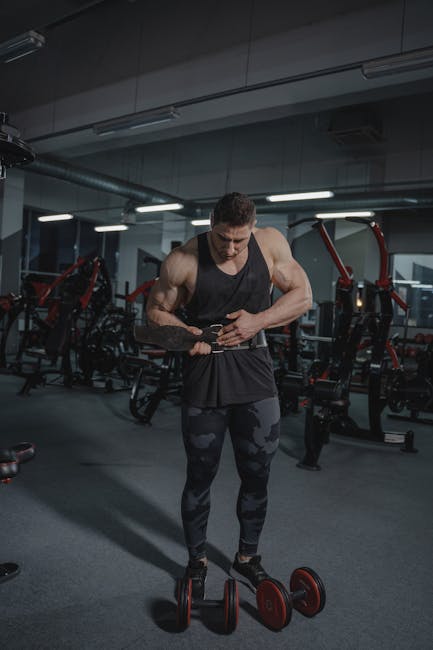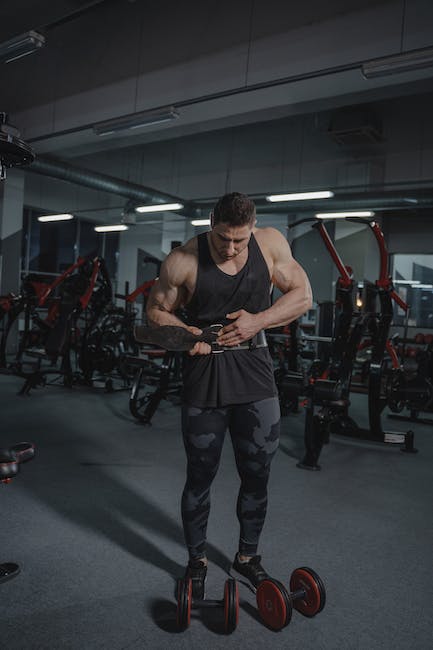Are you tired of feeling like your spine is about to snap in half every time you go for a PR on your deadlift? Do you long for the days when you could lift without fear of injury or embarrassment? Well, my friend, it’s time to buckle up and get serious about weightlifting belts. In this article, we’ll explore the ins and outs of using a weightlifting belt to maximize your lifts and avoid any potential back-breaking mishaps. So grab your favorite lifting shoes, chalk up your hands, and let’s dive into the exhilarating world of wearing a weightlifting belt.
Contents
- 1 1. Understanding the Function and Benefits of a Weightlifting Belt
- 2 2. Choosing the Right Type and Size for Your Body and Technique
- 3 3. Putting on and Securing the Weightlifting Belt for Maximum Effectiveness
- 4 4. Correcting Common Mistakes and Maintaining Proper Form
- 5 5. Incorporating the Weightlifting Belt into Your Training Program for Optimal Results
- 6 Strap It On and Lift Heavy!
1. Understanding the Function and Benefits of a Weightlifting Belt
So, you want to know about weightlifting belts huh? Well, young padawan, let me school you on the ways of the belt. First things first, what is its function? You see, it’s not just a fancy accessory to make you look cool at the gym; it actually serves a purpose. The belt is designed to support your lower back during heavy lifts, preventing injury and increasing your ability to lift heavier weights without hurting yourself.
But wait, that’s not all! The belt also helps you to maintain proper form and technique, which means you can lift with more precision and efficiency. And that means you’ll be seeing those gains in no time. Plus, if you’re anything like me, you’ll feel like an absolute beast when you strap on that bad boy and get to work.
Now, let’s talk benefits. Because who doesn’t love benefits? Besides the obvious perks of having a stronger back and being able to lift heavier weights, the belt can actually improve your overall performance in the gym. By supporting your core, you’ll have better stability and balance during your lifts. And let’s face it, nobody wants to look like a flailing fish out of water when attempting a heavy deadlift.
- So, in summary:
- The belt supports your lower back and helps prevent injury
- It helps you maintain proper form and technique
- It can improve your overall performance and stability
And if that’s not enough to convince you to invest in a weightlifting belt, well my friend, then I don’t know what will. Go forth and lift heavy!

2. Choosing the Right Type and Size for Your Body and Technique
When it comes to choosing the right type and size of instrument, it’s not just about aesthetics. You need to consider your body type and playing technique – otherwise, you might end up looking like a clown trying to play a miniature ukulele.
First and foremost, make sure the size of your instrument is proportional to your body. If you’re a towering giant, don’t go for a petite piccolo. On the other hand, if you’re more on the petite side, don’t go for a behemoth bass.
Secondly, consider your playing technique. If you’re all about fast and furious finger work, a smaller instrument might be best. Meanwhile, if you’re into shaking the rafters with your powerful playing, a larger instrument will give you the thunderous sound you crave.
In summary, when it comes to choosing the right type and size of instrument, you need to take into account your body size and playing style. By doing so, you’ll not only avoid looking like a musical misfit, but you’ll be able to play with more confidence and ease. And who knows – you might even find your perfect musical match!
3. Putting on and Securing the Weightlifting Belt for Maximum Effectiveness
First things first, make sure you have the right size weightlifting belt. You don’t want it to be too loose or too tight, otherwise, you’ll end up either smacking yourself in the face with the buckle or feeling like you’re being squeezed by a boa constrictor mid lift. Trust me, it’s not a good look.
Once you have the right size belt, place it around your waist just above your belly button. Make sure the back of the belt is centered on your lower back. This is where you’ll want to get a good arch going to maximize the effectiveness of the belt. And don’t forget to take a deep breath before buckling up!
Speaking of buckles, make sure it’s fastened tightly enough that the belt doesn’t shift around during your lift, but not so tight that you can’t breathe. You want to feel supported, not suffocated. And if you’re feeling extra fancy, give a little tug on the belt to engage your core before lifting. Bonus points for doing it with a dramatic flourish. With these tips, you’ll be ready to lift like a pro – or at least look like one.
4. Correcting Common Mistakes and Maintaining Proper Form
No one’s perfect, at least not in the gym. We all make mistakes and fall out of proper form from time to time. But never fear, because correcting common mistakes and maintaining proper form is as easy as remembering to flex those glutes.
First up, always remember to breathe. It can be tempting to hold your breath and clench your fists when you’re powering through a tough set, but that’s a recipe for disaster. Make sure to inhale before you lift and exhale as you exert yourself. Not only will it keep you from passing out, but it’ll give your muscles the oxygen they need to keep going. Plus, you’ll avoid that unfortunate “grunting in the gym” stereotype.
Second, don’t overdo it on the weights. It’s easy to get caught up in lifting heavier and heavier, but if you sacrifice proper form for a few extra pounds, you’ll end up doing more harm than good. Stick to weights that challenge you but don’t leave you reaching for a chiropractor. And remember, it’s not the quantity of the weight, it’s the quality of the reps.
Lastly, pay attention to your posture. Slouching and hunching your shoulders is a surefire way to throw off your form and set yourself up for injury. Make sure your shoulders are back and down, your chest is up, and your core is engaged. And don’t forget to stand tall – after all, you didn’t spend all that time in the gym just to slouch like a caveman.
5. Incorporating the Weightlifting Belt into Your Training Program for Optimal Results
So you’ve finally decided to take your gym sessions to the next level, and you’re thinking of incorporating a weightlifting belt? Congratulations, my fellow gym enthusiast! You’re on your way to becoming a bona fide meathead; there’s no turning back now.
But before you jump in with both feet (or should I say, both obliques?), there are a few important things you need to know. First things first, don’t just put on the belt and expect it to do all the work for you. This isn’t a Wonder Woman lasso that magically makes you stronger. You still have to put in the effort, buddy.
Secondly, make sure you’re using the belt for the right exercises. Don’t be that guy who straps it on for bicep curls; you’ll only end up looking like a tool. Stick to the big lifts like deadlifts, squats, and overhead presses.
- Tip #1: Tighten the belt so it’s snug, but not so tight that you can’t breathe. If you’re gasping for air like a freshly landed trout, you’re not doing it right.
- Tip #2: Don’t wear the belt for your entire workout. Save it for the heavy lifting sets, and take it off for the lighter stuff.
- Tip #3: Don’t be afraid to experiment with different widths and thicknesses of belts. It’s like Goldilocks and the three bears – you need to find the one that’s just right.
Now that you’re armed with these tips, go forth and conquer, young grasshopper. Just remember, with great power (and a weightlifting belt) comes great responsibility. Don’t let it go to your head, or your back might pay the price. Happy lifting!
Strap It On and Lift Heavy!
Congratulations, you’ve made it to the end of the article! Now that you have learned how to wear a weightlifting belt, you can finally stop using your grandma’s corset as a makeshift belt. Not only will your back thank you, but your lifts will skyrocket!
Just remember, a weightlifting belt is not a magical accessory that will instantly turn you into the Incredible Hulk. It’s simply a tool to help you lift heavier weights safely. So, keep working hard, keep pushing yourself, and don’t forget to strap that belt on tight before you hit the gym.
And if anyone ever asks why you wear a belt while lifting, just give them a flex and say, “Because I can.








Leave A Comment